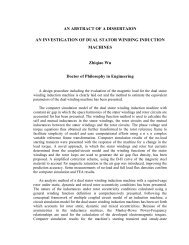CLIFFORD AND GRASSMANN HOPF ALGEBRAS VIA THE ...
CLIFFORD AND GRASSMANN HOPF ALGEBRAS VIA THE ...
CLIFFORD AND GRASSMANN HOPF ALGEBRAS VIA THE ...
You also want an ePaper? Increase the reach of your titles
YUMPU automatically turns print PDFs into web optimized ePapers that Google loves.
element R and try to compute all possible solutions to equation (2). Therefore<br />
we begin by defining R.<br />
> Y:=add(y[i]*bas[i],i=1..2^dim_V):<br />
> R:=proc(x,y) local bas,tr_tbl; option remember;<br />
bas:=cbasis(dim_V):<br />
tr_tbl:=table([seq(op(Clifford:-extract(bas[i]))=i,i=1..2^dim_V)]);<br />
R[tr_tbl[op(Clifford:-extract(x))],tr_tbl[op(Clifford:-extract(y))]]<br />
end proc:<br />
> RR:=add(add(contract(&t(bas[i],bas[j]),1,R)*<br />
&t(bas[i],bas[j]),i=1..2^dim_V),j=1..2^dim_V):<br />
Now the actual computation starts by evaluating the l.h.s. and r.h.s. of (2):<br />
> Leq:=gswitch(&cco(X),1):<br />
> Req:=&map(&map(switch(switch(&t(RR,&gco(X)),2),1),3,wedge),1,wedge):<br />
Note that in the right hand side of the equation Req, two switches were used<br />
to put R between the x(i)’s of the coproduct and are not part of formula (2)<br />
while the graded switch in the l.h.s. of the equation Leq is generic. This time<br />
we show directly how to solve tangle equations:<br />
> eq:=tcollect(Leq-Req):<br />
> vars:={seq(seq(R[i,j],i=1..2^dim_V),j=1..2^dim_V)}:<br />
> T:={seq(seq(&t(bas[i],bas[j]),i=1..2^dim_V),j=1..2^dim_V)}:<br />
> CO:={seq(x[i],i=1..2^dim_V)}:<br />
> sys:={}:<br />
> for t in T do<br />
for co in CO do<br />
sys:={op(sys),coeff(coeff(eq,t),co)};<br />
end do:end do:<br />
> sol:=solve(sys,vars):<br />
> matR:=matrix(2^dim_V,2^dim_V,(i,j)->R[i,j]):<br />
> ‘R‘=subs(sol,evalm(matR));<br />
⎡<br />
⎢ 1 0 0 0<br />
⎢ 0 −c1, 1 −c2, 1 0<br />
R = ⎢ 0 −c1, 2 −c2, 2 0<br />
⎣<br />
⎤<br />
⎥<br />
⎦<br />
0 0 0 c2, 1 c1, 2 − c2, 2 c1, 1<br />
We have put the solution once more into the matrix form for convinience.<br />
Inspection of this result shows that our R is the convolutive inverse of the<br />
coscalar product, and hence, it is exponentially generated. In fact it is an<br />
axiom of a quasi triangular structure that a convolutive inverse exists. We can<br />
check our assertion explicitly for arbitrary exponentially generated operators<br />
for any bilinear form K.<br />
S ◦ exp K = exp(−K)<br />
15
















